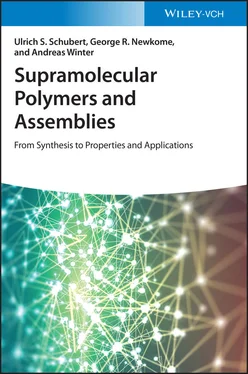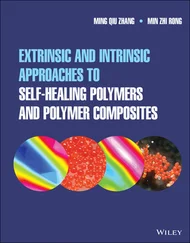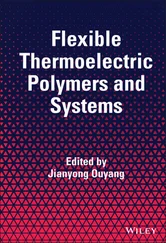9 Chapter 9Figure 9.1 Schematic representation of basic cyclodextrin (CD) structures. Source: Szejtli [4]. © 1997 American Chemical Society.Figure 9.2 (a) Schematic representations of a pseudorotaxane and a rotaxane. (b) Qualitative representation of the energy scheme for the disassembly of a [2] rotaxane into its molecular components. Source: Wenz et al. [11]. © 2006 American Chemical Society.Figure 9.3 Schematic representation of the synthesis of polypseudorotaxanes via two different approaches: multiple threading onto a preformed polymer and polymerization of a preformed pseudorotaxane monomer (a so‐called supramonomer). Source: Redrawn from Wenz [11]. © 2006 American Chemical Society.Figure 9.4 (a) Schematic representation of the two possible highly ordered modes for the packing of CD macrocycles along a polymer chain. (b) Schematic representation of a single‐ and double‐stranded assembly. Source: Redrawn from Ref. [11]. © 2006 American Chemical Society.Figure 9.5 (a) Solid‐state structure of an oligo(ethylene glycol) with threaded α‐CD rings and (b) scanning‐microscopy image of PEG with threaded α‐CD rings. (c) Plot of the threading kinetics of PEG and α‐CD (turbidity was measured by UV/vis absorption spectroscopy; the arrow indicates the end of the proposed induction period). Source: (a) Harada et al. [18]. © 2007 The Royal Chemical Society, (b) Arunachalam and Gibson [41]. © 2009 The Royal Chemical Society and © 1997 American Chemical Society, (c) Ceccato et al. [43]. © 1997 American Chemical Society.Figure 9.6 Schematic representation of the stimuli‐responsive self‐assembly of an azobenzene‐PEG‐CD conjugate. Source: Inoue et al. [45]. © 2007 The Royal Chemical Society.Figure 9.7 Schematic representation of the transformation of a randomly coiled polymer into a highly ordered crystalline state. Source: Tonelli [62]. © 2009 Springer Nature.Figure 9.8 Schematic representation of the polypseudorotaxane formation and isolation, the coalescence process, and the coalesced polymer. Source: Tonelli [62]. © 2009 Springer Nature.Figure 9.9 Schematic representation of the polydimethylsilane‐based polypseudorotaxane featuring a helix‐type conformation within the supramolecular assembly. Source: Redrawn from Ref. [76]. © 2003 The Royal Chemical Society.Figure 9.10 Schematic representation of a polypseudorotaxane formed by SWCNTs and η‐CD. Source: Dodziuk et al. [82]. © 2003 The Royal Chemical Society.Figure 9.11 Schematic representation of poly(bolaamphiphile)s 4–6used as macromolecular guests for polypseudorotaxane formation (the counterions are omitted for clarity). Source: Herrmann et al. [22]. © 1997 American Chemical Society.Figure 9.12 (a) Schematic representation of the self‐assembly of components 6and 7into a flexible poly[2]rotaxane; (b) possible modes of binding of Gal‐1 to this supramolecular receptor. Source: Nelson et al. [84]. © 2004 American Chemical Society.Figure 9.13 Schematic representation of polypseudorotaxanes, based on block copolymers, star‐shaped polymers, and graft/comb polymers. Source: Redrawn from Wenz et al. [11]. © 2006 American Chemical Society.Figure 9.14 Atomic‐force microscopy (AFM) images of the platelets formed by the aggregation of pluronics‐based polypseudorotaxane [(a) phase image, (b) topography image, scale bar: 1 μm]. Source: Perry et al. [91]. Figure reproduced with kind permission; © 2011 The Royal Chemical Society.Figure 9.15 Schematic representation of the triblock copolymer 8used for the site‐selective complexation by α‐CD. The resultant rod‐coil‐rod polymer featured a crystallization‐driven self‐assembly that could be modulated via the concentration and/or the pH value (two different morphologies, i.e. nanorings and nanorods, observed at different pH values are also shown). Source: Qi et al. [103]. © 2015 John Wiley and Sons.Figure 9.16 Schematic representation of the site‐selective complexation of a diblock copolymer by β‐CD moieties. A representative TEM image of the micelles assembled from the resultant amphiphilic pseudorotaxane‐PS diblock copolymer in water is also shown. Source: Cho and Allcock [114]. Figure reproduced with kind permission; © 2009 American Chemical Society.Figure 9.17 Schematic representation of the synthetic routes toward (a) polyrotaxanes with terminal stopper moieties, (b) polyrotaxanes with stopper moieties within the main chain, and (c) polyrotaxanes with stopper moieties attached to the main chain. Source: Wenz et al. [11]. © 2006 American Chemical Society.Figure 9.18 Schematic representation of a polyrotaxane formation facilitated by supramolecular host–guest chemistry. Source: Herrmann et al. [123]. © 1997 John Wiley and Sons.Figure 9.19 Representative scanning‐tunneling microscopy (STM) images of the polyazamethine‐based polyrotaxane on a highly ordered pyrolytic graphite (HOPG) surface (a) 2D representation, (b) 3D representation, (c) Molecular model of the structure. Source: (a, b) Liu et al. [126]. Figure reproduced with kind permission. © 2004 American Chemical Society.Figure 9.20 Schematic representation of the three‐step synthesis of polyrotaxanes, featuring π‐conjugated backbones. Source: Michels et al. [25]. © 2003 John Wiley and Sons.Figure 9.21 Schematic representation of the synthesis of a poly[2]rotaxane with a π‐conjugated polymer backbone. Source: Redrawn from Terao [133]. © 2011 The Royal Chemical Society..Figure 9.22 (a) Schematic representation of a chain‐extended polyrotaxane formed by a photochemical dimerization of the attached 2‐anthryl end groups. (b) Schematic representation of the reversible formation of linear chain‐extended polyrotaxanes and polycatenanes from a polyrotaxane. Source: (a) Okada et al. [136]. © 2004 American Chemical Society, (b) Okada et al. [137]. © 2003 American Chemical Society.Figure 9.23 Schematic representation of the supramolecular polymerization using (a) a heteroditopic AB‐type CD–guest conjugate, (b) an equimolar mixture of homoditopic CD–CD dimer and guest dimer (AA‐ and BB‐type monomers, respectively), and (c) a CD of sufficient cavity size and a BB‐type guest dimer. Source: Redrawn Yang et al. [138]. 2015 American Chemical Society.Figure 9.24 Schematic representation of the host–guest conjugates 12and the supramolecular polymer poly‐ 12a. Source: Harada et al. [140]. © 2001 Springer Nature.Figure 9.25 Schematic representation of the (a) double‐threaded dimer and (b) daisy‐chain trimer, obtained from the self‐assembly of CDC;C–cinnamoyl conjugates. Source: Hoshino et al. [142]. © 2000 The Royal Chemical Society.Figure 9.26 (a) Schematic representation of the host–guest conjugate 13and its self‐assembly into a helical supramolecular polymer. (b) STM image of poly‐ 13deposited onto a MoS 2substrate. Source: (a) Miyauchi et al. [145]. © 2005 American Chemical Society.Figure 9.27 Schematic representation of the AB‐type monomer 14for which supramolecular polymerization was enabled; whereas, the competing pathways were disabled. A representation of the SANS data, which corroborated a cylindrical structure of poly‐ 14with a length and diameter of c. 6.6 and 1 nm, respectively, is also shown. Source: Evenou et al. [146]. © 2018 John Wiley and Sons.Figure 9.28 Schematic representation of the self‐assembly of 15and 16into an alternating supramolecular copolymer. Source: Miyauchi and Harada [147]. © 2004 American Chemical Society.Figure 9.29 Schematic representation of the synthesis of a poly[2]rotaxane from the self‐assembly of the AB‐type [2]rotaxane monomer 17. Source: Miyauchi et al. [148]. © 2005 American Chemical Society.Figure 9.30 Schematic representation of the homoditopic AA‐ and BB‐type components 18and 19, respectively, utilized for the supramolecular polymerization. Source: Ohga et al. [149]. © 2005 American Chemical Society.Figure 9.31 Schematic representation of the formation of a supramolecular polymer using the monomers γ‐CD and 20. The supramolecular polymer could reversibly be converted into a covalent polymer, upon light irradiation. Source: From Zhang et al. [153]. © 2013 American Chemical Society.Figure 9.32 Schematic representation of the formation of a POM‐containing polyrotaxane by a supramolecular polymerization and subsequent light‐driven anthracene dimerization. Representative TEM images showing fibrous bundles and isolated polymer chains are also depicted. Source: Guan et al. [154]. Figure reproduced with kind permission; © 2019 The Royal Chemical Society.Figure 9.33 Schematic representation of the formation of a supramolecular diblock copolymer, based on a CD–adamantyl host–guest complex [PNIPAM: poly( N ‐isopropyl acrylamide), PMeOx: poly(2‐methyl‐2‐oxazoline)]. Source: Redrawn from Ref. [172]. © 2011 American Chemical Society.Figure 9.34 Schematic representation of the assembly of core–corona micelles from the polystyrene–β‐CD conjugate. Source: Giacomelli et al. [168]. © 2009 American Chemical Society.Figure 9.35 Schematic representation of the amphiphilic supramolecular diblock copolymer, which exhibited a redox‐responsive behavior due to the selectivity of β‐CD to bind Fc and to release Fc +. The TEM images show the reversibility of the voltage‐driven disassembly/reassembly process. Source: Yan et al. [169]. © 2010 The Royal Chemical Society.Figure 9.36 Schematic representation of the formation of light‐responsive nanotubes, assembled from an amphiphilic supramolecular diblock copolymer, for the controlled release of rhodamine‐B. The release rate, as a function of the irradiation time, is also shown. Source: Yan et al. [171]. Figure reproduced with kind permission; © 2010 American Chemical Society.
Читать дальше












